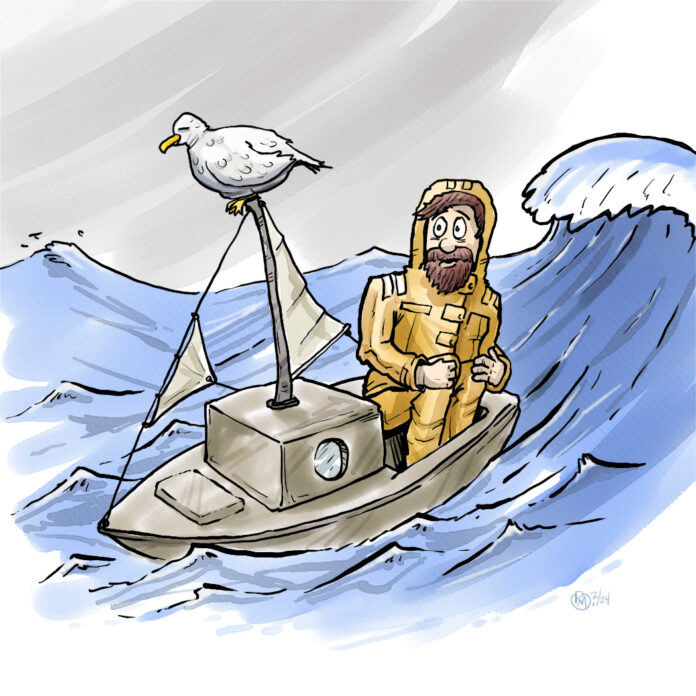Roger Taylor seems to inspire many small boat single-handed sailors in UK. I might be very wrong, but just he doesn’t do that for me. I’d never try and do some of his trips because it would be being locked up again when I was in the army in a small space; and, not seeing the Ocean properly from on deck and eyeballing many doggy land falls.
There’s no doubt you can have fun single handing in a wee boat! Back in the Eighties, after a slow (35-day) Atlantic crossing on my 22ft’er, my budget needed a boost, and I came up with the perfect solution! I’d left rather late, in March from the Canaries, and the holiday season was almost over in the Carib. Any casual work with boats would be difficult to find once the hurricane season started.
I talked to a few friends running big charter boats from Antigua and learned that coffee and outboard motors were much cheaper in Venezuela. Perhaps I could make some money from my small, engineless boat, if I brought some of these items back? What a convenient way of boosting my finances! Stowage would be limited on Miss Content, and my first customer – a friend of mine – requested quite a sizable outboard motor!
There was in no rush, and it was wonderful to run into an old friend, Tom, onboard Shuffle in Martinique. He’d finally done it and crossed the Atlantic alone! I’d met him in the Azores a couple of years ago with his 23ft steel double-ender. It was a boat that could take you anywhere, but he’d had a bad experience on his first long trip on a cold-moulded Atalanta, when his rudder fell off in Biscay. Understandably, he’d been more cautious this time round. Tom hadn’t pulled up his anchor for a while at Anise des Flames. We spent an enjoyable afternoon racing each other!
Next, I visited Saint Lucia, before heading into the dreamlike Admiralty Bay anchorage at Bequia. Seeing two more old friends: Flo, Dudley and their young child on Cap Horn, a wooden 22-footer, was lovely. Dudley was running the little boatyard and slip, and I spent a pleasant week with them, catching up on their news.
Following that, I had good stops in Union Island and Carriacou, and a short stop in a bay on the northwest coast of Grenada. The capital, St George’s, was where I obtained a visa for Venezuela.
Here I met Trevor Osben, a remarkable single-handed sailor from Brightlingsea. He’d crossed the pond on a home-built stitch and glue 20ft plywood boat called ‘Chess’ and was heading west. He’d had a whole series of catastrophes, including rigging failure, rudder problems and a fire on board, but this hadn’t put him off. We teamed up to sail west in company, planning to call at Los Testigos, 45 miles away. This small uninhabited island group, occasionally used by Venezuela fisherman, was named by Columbus when he first made landfall in the New World.
We placed a wager on who would be the first to arrive. Although Chess was smaller by two feet, she ought to plane in good wind, whereas Miss C would only surf, which made it fair!
The pilot book told us to expect a strong west-going current around the end of South America on this leg, and to see a small light on the Testigos group. However, I ended up slowing my boat down and waiting for dawn to break, spotting no light at all. We later learned from the local fishermen that the light only worked if someone took a car battery up the hill, to power it!
Los Testigos was idyllic, with golden sandy beaches surrounded by light blue sea teaming with marine life. After a two-day break spent exploring, we both left Los Testigos making it into the island of Margarita just before sunset. Amazingly, there were another two small British yachts anchored here; a newly married couple on a 27ft boat, and single hander, Tim
Wright, onboard his Elizabethan 29, ‘Andara’. They were old friends and cruising in company.
Trevor was bound for Panama and the Pacific, so we gave him charts and anything else that might help him. Trevor went on to complete his circumnavigation – it would take him four years, but sadly he was lost at sea in 1991 whilst heading south from the UK towards South Africa.
The newlyweds also left to cruise Venezuela, leaving Tim and I to chill out for a few weeks on the local beer, which was extraordinarily cheap! Finally, Tim headed down towards Caracas to see a girl who lived there, going via a boatyard for an inexpensive refit. He went on to become a well-known marine photographer of classic yachts, taking pictures from his RIB, in the Caribbean and Mediterranean.
Sailing north with a very large outboard motor took up my whole cabin sole, and coffee tins were stuffed everywhere; it didn’t make for the comfiest sailing! Against the northeast Trades and a strong foul current was a tough beat. I had a pit-stop in Los Testigos after a 48-hour slog, then anchored in Deshaye’s, Guadalupe, drying out, at last, after a five-day bash. Next was a quick dash to English Harbour, Antigua to discharge my freight!
Within six hours of arriving in harbour, I felt very merry from the number of rum friends tipped down my throat, and before I knew it, I was offered another delivery with a good north to the USA. A great pal Ted Jenkins kept an eye on Miss C after I’d moved her into the Mangroves and moored what I hoped was Hurricane safe.
Things have changed. For better or worse folks don’t cruise like this anymore!



